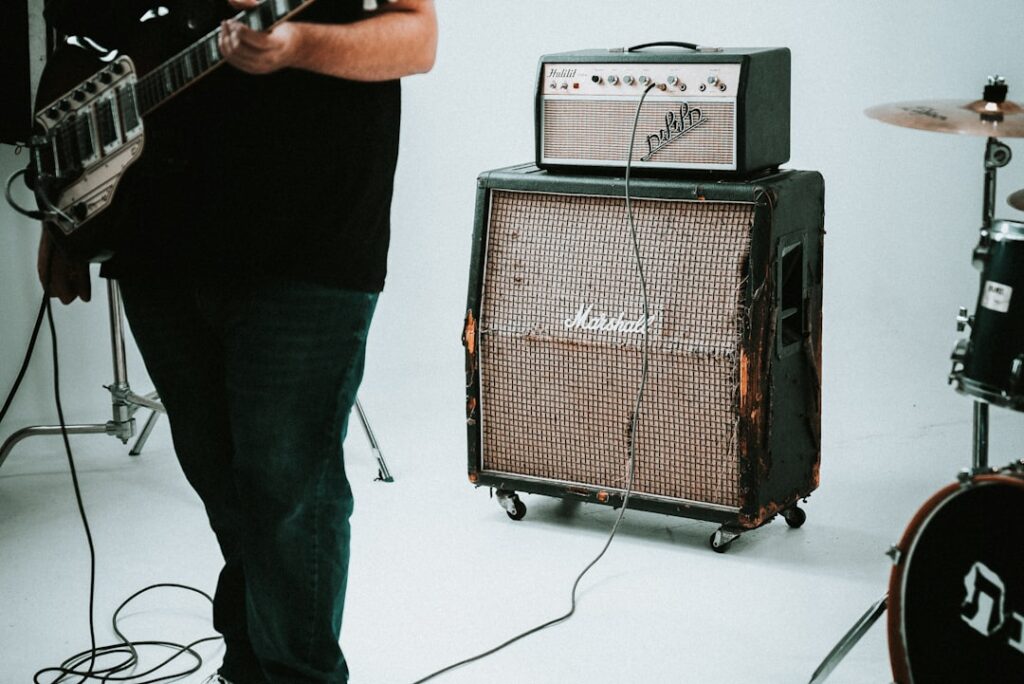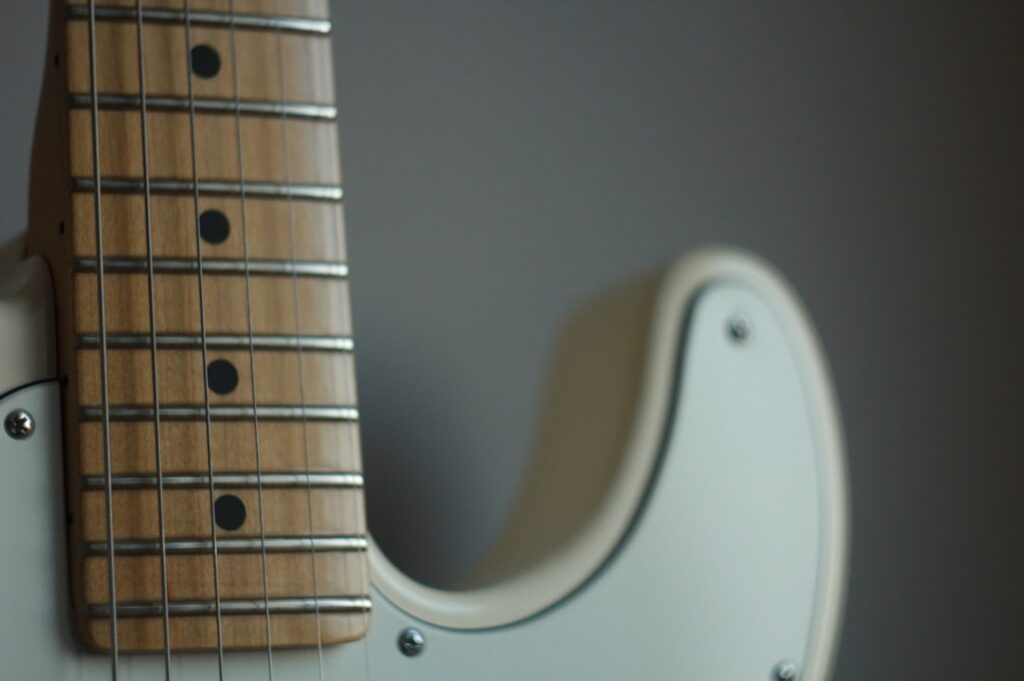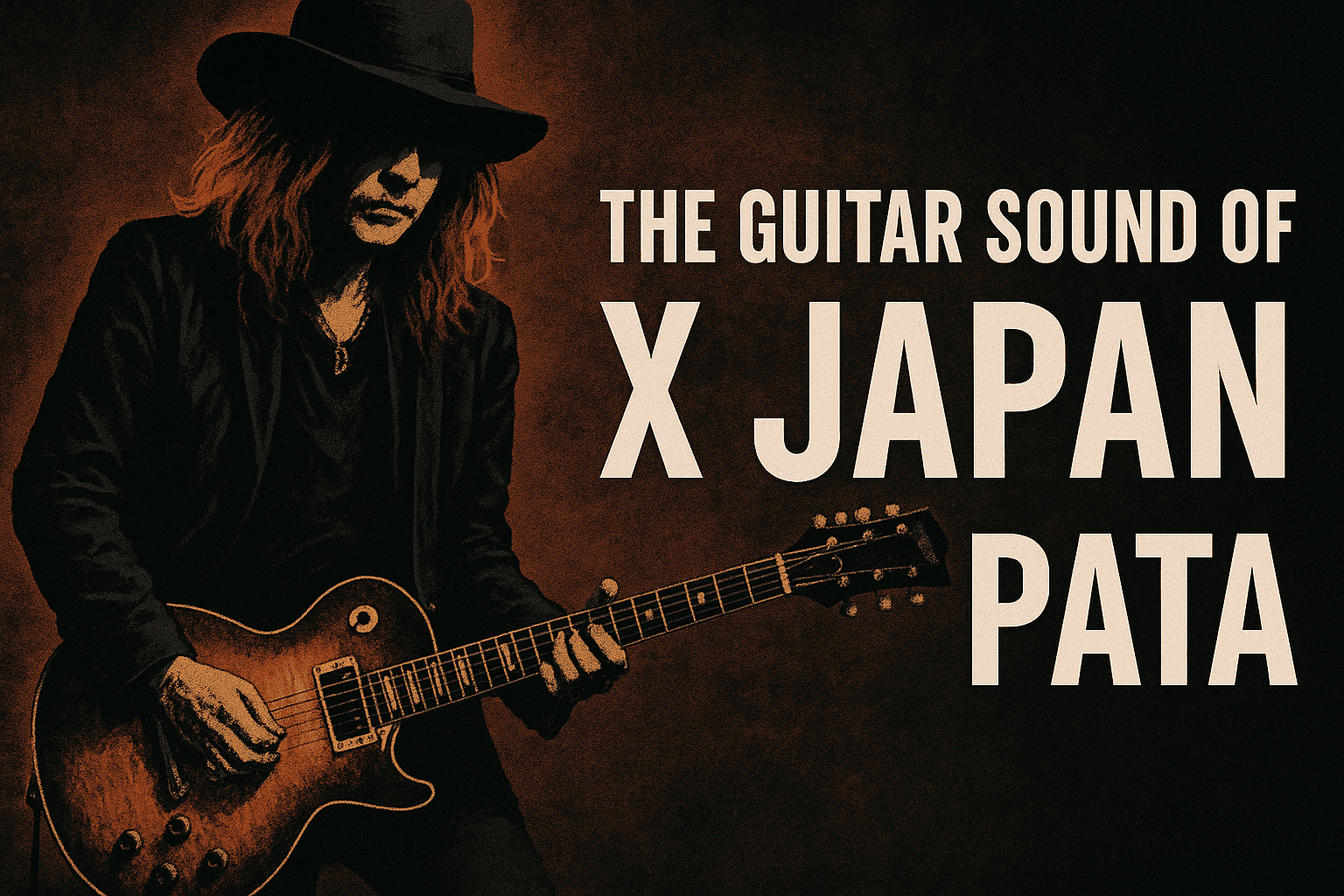Introduction: Defining PATA’s Signature Sound
As the long-time guitarist of X JAPAN, PATA has been the solid foundation behind the band’s epic, orchestral metal sound. While his presence on stage may be understated compared to flamboyant figures like hide, his guitar tone delivers undeniable power and grit that holds the band’s sound together.
PATA’s tone is built on a classic rock foundation—rich in midrange and punch—yet it fits perfectly within the symphonic metal and visual kei genre that defines X JAPAN. What sets his sound apart is its clarity: a distorted tone that remains articulate even in dense arrangements.
At the heart of his tone lies a simple but powerful combo: vintage Gibson Les Paul guitars paired with vintage Marshall amps. He avoids excessive effects, relying instead on the raw tube drive of his amps. Occasional boosts, wah, and phaser pedals are used sparingly and tastefully, often for solos or subtle shifts in tone.
In signature tracks like “Kurenai” and “Rusty Nail,” PATA’s thick, low-end-heavy rhythm guitar contrasts perfectly with hide’s sharp and edgy tones. In “Forever Love,” you can hear him using a whammy pedal to add sonic depth, while switching guitars mid-track for solos shows his meticulous attention to sonic detail in the studio.
His sound is also supported behind the scenes by his guitar tech, Toru Saito, who handles effects switching and fine-tuning tones on stage and in the studio. Thanks to this collaboration, PATA’s sound remains highly professional and consistent in both live and recording environments.
PATA’s gear often trends on social media as fans dissect his use of iconic Burny models, korina-bodied guitars, and, in recent years, his integration of Friedman amps—blending vintage tradition with modern punch.
Next, let’s dive into the cornerstone of his sound: his amps.
▶ Search X JAPAN official videos on YouTube
Amps Used by PATA [X JAPAN]

PATA’s tone begins with a raw and direct amp setup, centered around vintage Marshall JMP heads. These amps are the core of both his live and studio tone. He primarily uses a 1974 Marshall JMP as his main amp, prized for its strong low-mid gain. A 1968 JMP is often paired with it to enhance low-end depth and broaden the frequency response.
Both amps have been modified to include master volume and send/return circuits, allowing modern stage flexibility while preserving their vintage character.
He also utilizes other amps as secondary tools: the Friedman JJ-100 Jerry Cantrell Signature Head adds a modern, tighter distortion and is believed to be used on tracks like “JADE.” The Marshall Vintage Modern 2466 delivers rich overtones and warm crunch tones, making it a go-to for midrange-driven riffing.
Cabinet-wise, PATA pairs his amps with the Friedman 412 Vintage Cabinet, which complements both his Friedman and Marshall heads with a classic-voiced speaker configuration.
In earlier years, he also experimented with HIWATT Custom Hiwatt amps for clean tones. True to his philosophy, though, PATA crafts most of his distortion directly from his amp heads rather than relying on pedals—championing a “pure amp tone” approach that shines even in X JAPAN’s complex arrangements.
This amp-centric setup ensures his guitar always cuts through the band’s majestic soundscape, delivering warmth, body, and authority on every note.
| Gear | Brand | Amazon Link | Band | Guitarist | Notes |
|---|---|---|---|---|---|
| JMP ’74 | Marshall | Search on Amazon | X JAPAN | PATA | Main amp. Modified with master volume and FX loop |
| JMP ’68 | Marshall | Search on Amazon | X JAPAN | PATA | Used for low-end support and added width |
| JJ-100 Jerry Cantrell Signature | Friedman | Search on Amazon | X JAPAN | PATA | Used in post-reunion shows like “JADE” |
| Vintage Modern 2466 | Marshall | Search on Amazon | X JAPAN | PATA | Great for warm, mid-heavy crunch tones |
| 412 Vintage Cabinet | Friedman | Search on Amazon | X JAPAN | PATA | Classic-voiced cab, pairs well with Marshalls |
| Custom Hiwatt | HIWATT | Search on Amazon | X JAPAN | PATA | Previously used for clean tones |
Guitars Used by PATA [X JAPAN]

PATA’s guitar arsenal reflects his dual passion for vintage craftsmanship and road-tested reliability. At the heart of his collection are several vintage Gibson Les Paul models, each with its own nickname and story, many of which have been with him since the early days of X JAPAN.
One of the most iconic guitars he uses is a 1955 Gibson Les Paul Standard, affectionately known as “Hage” (Japanese for “baldy”). It’s a heavily modified instrument, typically used with the bridge pickup for rhythm and switched to the neck pickup for solos. Its punchy, raw tone is a perfect match for hard rock riffing.
Another go-to is the 1975 Les Paul Custom, nicknamed “Kurokasu” (Black Custom) or “Joumu-kun” (a playful nickname). This guitar has been with PATA since his amateur days and has undergone numerous repairs—including neck breaks, pickup replacements, and fret changes—but still remains an active part of his rig.
In studio sessions, especially for solos, he often turns to his prized 1959 Les Paul Standard, dubbed “No.1” or “My Wife.” With its thick tone and rich sustain, it adds sonic weight to recordings while retaining clarity and definition.
For live performances since around 2009’s “JADE,” PATA has introduced a Les Paul Custom (white) from the Custom Collection series, specifically set up for drop tuning. He also owns several other white Gibson Customs for use depending on the song’s tuning and feel.
PATA has also wielded a Gibson EDS-1275 double-neck, customized in the style of Jimmy Page. Though it’s no longer used in live shows due to its weight, it remains a notable part of his legacy rig. For heavier post-reunion songs like “JADE,” he’s been seen using a Gibson ’76 Les Paul Custom in wine red, outfitted with a Tom Holmes 453 pickup in the bridge for added output.
Among his custom guitars is the Burny PATA MODEL, a korina-bodied Explorer-style guitar known for its strong attack and midrange clarity. This model is especially prominent on songs like “SCARS” and “BORN TO BE FREE.” He also owns a rare Burny hide MODEL proto type, gifted by hide himself, which made appearances during MSG and Wembley performances.
For acoustic performances and studio sessions, PATA has been seen using a mix of pre-war CF.Martin acoustics, Ovation, and Takamine guitars—particularly on tracks like “Hurry Go Round.”
He also owns various Fender-style guitars including Stratocasters (notably a Jeff Beck model), Jazzmasters, and Mustangs. Additionally, a Burny Les Paul from his indie years rounds out his historic collection.
Regardless of the brand or model, one thing stays consistent in PATA’s philosophy: every guitar must deliver rock-ready tone—clear mids, full lows, and natural projection. His gear choices prioritize reliability and tonal character over flashy looks, embodying his down-to-earth yet professional approach to guitar playing.
| Gear | Brand | Amazon Link | Band | Guitarist | Type | Notes |
|---|---|---|---|---|---|---|
| Les Paul Standard ’55 | Gibson | Search on Amazon | X JAPAN | PATA | Les Paul | Nicknamed “Hage”, heavily modded, used with bridge pickup |
| Les Paul Custom ’75 | Gibson | Search on Amazon | X JAPAN | PATA | Les Paul | “Kurokasu”, used since amateur days; repaired multiple times |
| Les Paul Standard ’59 | Gibson | Search on Amazon | X JAPAN | PATA | Les Paul | Nicknamed “No.1”, go-to for solo recording |
| EDS-1275 | Gibson | Search on Amazon | X JAPAN | PATA | Double Neck | Modified to Page specs, retired from live use |
| Burny PATA MODEL | Burny | Search on Amazon | X JAPAN | PATA | Explorer | Korina wood, used on “SCARS” and others |
| Burny hide MODEL proto type | Burny | Search on Amazon | X JAPAN | PATA | Explorer | Gift from hide, used at MSG and Wembley |
| Takamine Acoustic | Takamine | Search on Amazon | X JAPAN | PATA | Acoustic | Featured on “Hurry Go Round” |
| Pre-war CF.Martin | Martin | Search on Amazon | X JAPAN | PATA | Acoustic | Rare vintage models used in sessions |
Effects and Pedalboard Setup [X JAPAN – PATA]
PATA’s approach to effects is refreshingly minimalistic. Rather than layering multiple pedals, he prioritizes direct amp gain and only employs essential tools to shape the tone as needed. His pedalboard serves as a refined toolkit—focused, efficient, and purpose-driven.
The core philosophy? “Get your distortion from the amp, not the pedals.”
Among the few carefully chosen effects on his board are the wah pedal, phaser, delay, and a clean boost—each selected for its ability to subtly enhance tone or bring focus to solos. These are not constantly active but strategically engaged depending on the part of the song.
At the center of his board is the Providence PEC-2, a programmable effects controller that allows seamless switching between pedal combinations and rack units. It links to a backstage rig operated by his guitar tech, Toru Saito, who ensures smooth transitions and maintains tone integrity during performances.
PATA’s delay of choice is the FREE THE TONE FLIGHT TIME, set up backstage to add just a touch of depth and ambiance. For modulation, he uses the MXR PHASE 100, typically dialed in gently to provide extra movement around solos without overpowering the signal.
When a solo needs to pop through the mix, he activates a Creation Audio Labs MK.4.23 Boost, a clean boost pedal that raises volume without coloring the tone. To maintain sonic clarity, he relies on the iSP Technologies Decimator ProRack G, which eliminates unwanted noise without affecting the natural breakup of his Marshall amps.
Another standout in his rig is the Digitech Whammy 2, used for pitch-shifting effects—particularly noticeable on ballads like “Forever Love,” where two-octave shifts create dramatic sonic effects.
Supporting gear includes a DOD 240 line mixer, KORG VP-10 volume pedal, amp selectors, and a wireless system. These elements contribute to a highly optimized and efficient setup that, while visually simple on stage, is sophisticated and deliberate behind the scenes.
Below is a categorized list of the effects confirmed in PATA’s rig:
| Gear | Brand | Amazon Link | Band | Guitarist | Type | Notes |
|---|---|---|---|---|---|---|
| Clyde McCoy Signature Wah | VOX | Search on Amazon | X JAPAN | PATA | Wah Pedal | Used expressively during live solos |
| PEC-2 | Providence | Search on Amazon | X JAPAN | PATA | Switching System | Main foot controller linked to rack units |
| Decimator ProRack G | iSP Technologies | Search on Amazon | X JAPAN | PATA | Noise Suppressor | Removes noise without harming tube tone |
| FLIGHT TIME | FREE THE TONE | Search on Amazon | X JAPAN | PATA | Delay | Subtle delay for space and depth |
| PHASE 100 | MXR | Search on Amazon | X JAPAN | PATA | Phaser | Used subtly around solos |
| MK.4.23 Boost | Creation Audio Labs | Search on Amazon | X JAPAN | PATA | Booster | Clean volume boost for solos |
| Whammy 2 | Digitech | Search on Amazon | X JAPAN | PATA | Pitch Shifter | Used in “Forever Love” for dramatic pitch effects |
| 32volt Over Drive | Ex-pro | Search on Amazon | X JAPAN | PATA | Overdrive | Delivers natural, amp-like distortion |
Tone Settings, EQ, and Mixing Tips [X JAPAN – PATA]

PATA’s tone is defined by two things: fat, unshakable presence in a dense band mix, and natural midrange that never becomes harsh. His sound is carved with precision, shaped not just by gear, but by thoughtful EQ and subtle touch-based dynamics.
At the core is his trusted Marshall JMP setup (1974 & 1968 models), dialed in to deliver vintage-style crunch with enough clarity and punch to stand out—even when layered beneath orchestral strings, synths, and two drum kits (in the case of “Art of Life”).
His amp settings are relatively conservative in gain, allowing dynamics to be controlled from the guitar itself. Using the bridge pickup as a base tone, he often switches to the neck pickup and rolls off the tone knob during solos to create a midrange-focused lead sound.
Estimated amp settings for the JMP ’74:
- Presence: 3–4
- Bass: 5–6
- Middle: 6–7
- Treble: 4–5
- Master Volume: Around 7
- Gain: 4–5 (just enough for pick attack to break it up)
These settings help deliver a warm and present tone with strong mids that cut through, without becoming piercing. The 1968 JMP complements this by providing additional low-end reinforcement and spatial dimension via cabinet interaction.
From an EQ perspective, PATA avoids boosting bass too much, instead aiming for separation from the kick drum and bass guitar. His philosophy is to build tone around the mids—this not only helps his sound stand firm in the mix, but also makes life easier for the FOH engineer.
In recording sessions, he frequently switches to the 1959 Les Paul Standard “No.1” for solos to gain more sustain and richness. Miking techniques usually involve a blend of a Shure SM57 and a Royer R-121 ribbon mic, phase-aligned for width and depth in stereo tracking.
Importantly, PATA does not overpower the mix with guitar levels. In epic compositions like “Art of Life,” his rhythm parts are designed to “breathe within the band,” allowing other elements to shine. But when it’s time for a solo, a well-timed boost and EQ shift bring the guitar to the front with authority.
On stage, his Providence PEC-2 controller allows different tone setups to be instantly recalled for each song, working seamlessly with backstage effects units like delay and phaser to ensure consistency and ease of operation.
The MK.4.23 Boost plays a vital role—not for extra gain, but for pushing volume and midrange presence during leads. Occasionally, the Whammy pedal is added into solos for dramatic flair, further diversifying his otherwise dry tone palette.
In summary, PATA’s tone design is centered around a minimalist philosophy: get the core tone from the amp, sculpt it carefully with EQ, and use only essential effects to preserve the “liveness” and honesty of his sound. This approach allows him to remain a sonic pillar in X JAPAN’s elaborate arrangements while staying true to classic rock roots.
Affordable Alternatives for Approximating PATA’s Tone
Recreating PATA’s tone doesn’t necessarily require a collection of vintage Gibsons and Marshalls. If you’re just starting out or working with a limited budget, there are several gear options that can bring you surprisingly close to his core sound.
Below are some cost-effective alternatives that capture the spirit of PATA’s setup, ideal for home practice or entry-level live use:
| Gear | Brand | Amazon Link | Description |
|---|---|---|---|
| Les Paul Studio | Epiphone | Search on Amazon | A budget-friendly alternative to Gibson Les Pauls with warm mids and solid sustain. |
| DSL20CR | Marshall | Search on Amazon | A compact tube amp perfect for capturing vintage crunch at manageable volumes. |
| DS-1 Distortion | BOSS | Search on Amazon | Simple, reliable distortion pedal to help emulate Marshall-like gain without breaking the bank. |
| Mini Cry Baby Wah | Dunlop | Search on Amazon | A compact wah pedal that fits smaller boards while retaining classic sweep tones. |
These options won’t completely replicate the unique sonic character of PATA’s vintage rig, but they’ll bring you close enough to start learning the touch, phrasing, and tone control that define his style.
Final Thoughts: What Defines PATA’s Sound

If we were to describe PATA’s tone in one phrase, it would be: “straightforward, honest rock sound.” His guitar tone is never flashy or over-processed, but always full-bodied, grounded, and supportive—the kind of tone that anchors an entire band.
The foundation of his sound is amp-driven distortion. He gets his gain from vintage Marshalls, controlling dynamics through picking intensity and guitar volume knobs. Effects are used selectively—boosters, wah, phaser, and delay—each deployed with precision to add just the right amount of texture when needed.
PATA’s choice of gear reflects deep commitment and experience. His arsenal includes vintage Gibson Les Pauls from the ’50s to ’70s, and decades-old Marshalls—chosen not just for tone, but for how they resonate and “breathe.” Each guitar carries a nickname and personal history, showing his affection and loyalty to instruments that have stood the test of time.
Another key element of his sound is his role within X JAPAN. While hide brought flamboyant leads and cutting-edge tones, PATA held the line—always playing what was needed, never too much, never too little. His parts support the song, the band, and the overall emotional flow of each track.
Behind the scenes, his consistency is made possible by a highly coordinated rig and a professional support team. Whether live or in the studio, his tone remains solid thanks to a well-built system that allows him to focus entirely on performance.
If you’re aspiring to capture his tone, remember: it’s not just about owning the same gear—it’s about understanding the philosophy behind it. Think about which frequencies to push, when to boost, and when to back off. Tone is more than sound; it’s intention.
And above all, what makes PATA’s tone resonate with so many is his genuine love for music and deep respect for his tools. If you carry that spirit into your playing, you’ll be well on your way to creating your own version of the PATA sound.






